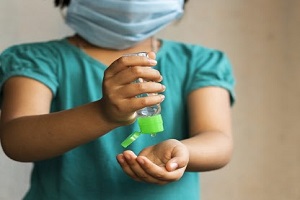COVID-19: Adults are a more common source of infection than children
11/05/2021
Cristina Azevedo (Fiocruz News Agency)
Although studies suggest that children and adolescents attending summer camps and social events may carry COVID-19 into their homes, work by researchers at the Oswaldo Cruz Foundation (Fiocruz), the University of California (UCLA), and the London School of Hygiene and Tropical Medicine (LSHTM) indicates that they more often become infected by adults than act as transmitters.
 A preview of the article SARS-CoV-2 Infection Dynamics in Children and Household Contacts in a Slum in Rio de Janeiro, to be published in Pediatrics, Official Journal of the American Academy of Pediatrics, explains that the study involved 667 participants in 259 households from May to September 2020. Of these, 323 were children (0 to 13 years old), 54 adolescents (14 to 19 years old), and 290 adults. The tests of 45 children (13.9%) were positive for the virus. The study also shows that infection was more frequent in children under 1-year-old and in the 11 to 13-year-old age group. All had had contact with an adult or adolescent with COVID-19 recent signs. If compared with data from Rio, the study shows that one-third of household contacts surveyed had been exposed to the virus by August 2020, a higher rate than that recorded in the city's general population in the same period: 33% against 7.5%.
A preview of the article SARS-CoV-2 Infection Dynamics in Children and Household Contacts in a Slum in Rio de Janeiro, to be published in Pediatrics, Official Journal of the American Academy of Pediatrics, explains that the study involved 667 participants in 259 households from May to September 2020. Of these, 323 were children (0 to 13 years old), 54 adolescents (14 to 19 years old), and 290 adults. The tests of 45 children (13.9%) were positive for the virus. The study also shows that infection was more frequent in children under 1-year-old and in the 11 to 13-year-old age group. All had had contact with an adult or adolescent with COVID-19 recent signs. If compared with data from Rio, the study shows that one-third of household contacts surveyed had been exposed to the virus by August 2020, a higher rate than that recorded in the city's general population in the same period: 33% against 7.5%.
For the researchers, "the children included in the study do not appear to be the source of Sars-CoV-2 infection and more often acquired the virus from adults." "Our findings suggest that in scenarios like the one studied, schools and day care centers could potentially reopen if safety measures against COVID-19 were taken and staff adequately immunized," the text says.
Poorly Symptomatic
Because children are generally poorly symptomatic and tend to follow less hygiene and social distancing protocols, they could be a source of transmission, the study recalls, which has motivated many countries to close schools early and keep them closed for long periods. "A better understanding of the children's role in transmission dynamics is a key importance for developing guidelines for the schools and other public spaces safe reopening, and the immunization strategies development," the article says. For the researchers, this is particularly important in poor communities where there are a large number of people living in the same house.
The starting point for the research was the follow-up of children under 14 years old who sought some kind of care at the Germano Sinval Faria School Health Center, of the Sergio Arouca National School of Public Health (ENSP/Fiocruz), in Manguinhos. These children were then visited at home and subjected to PCR and serology (IgG) tests. Adults and adolescents in these homes were also tested.
"We inferred that if Sars-CoV-2 transmission was primarily from adults and adolescents to children, those with positive PCR would have had contact with an adult or adolescent with positive IgG antibodies to Sars-CoV-2 or a COVID-19 previous medical history suggestive. In addition, we evaluated the Sars-CoV-2 peak prevalence timing of IgG in children vs. adults and adolescents. Our hypothesis is that if transmission was primarily from adults and adolescents to children, the peak prevalence of IgG in adults and adolescents would occur before the peak prevalence of IgG in children", the article states.
"Unless these children were Sars-CoV-2 carriers for a long period, our results are compatible with the hypothesis that they become infected through household contacts, primarily with their parents," the article says, "rather than transmitting to them." The study, however, points out that the period of its completion coincided with the schools closing. "Adults may have been the most important propagators because they continued to work outside the home, continuously exposed in transportation and workplaces," the article says. The authors draw attention to the fact that the study results refer to the location and period studied (May to September 2020), different from the current scenario with a new, more transmissible, circulating variant of the virus.
Coordinated by Patrícia Brasil, head of the Laboratory of Clinical Research in Acute Fever Diseases of the Evandro Chagas National Infectology Institute (INI/Fiocruz), the study also included the participation of researchers Pâmella Lugon, Luana Damasceno, Guilherme Calvet, Paola Cristina Resende, Aline Rocha Matos, Tulio Machado Fumian, Fábio Correia Malta, Aline Dessimoni Salgado, Fernanda Christina Morone Fernandes, Liege Maria Abreu de Carvalho, Lusiele Guaraldo, Leonardo Bastos, Oswaldo Gonçalves Cruz, Marilda Siqueira, and Marilia Sá Carvalho (all from the Foundation), as well as Trevon Fuller (Fiocruz and University of California), Karin Nielsen-Saines (University of California), James Whitworth, and Chris Smith (both from the London School of Hygiene and Tropical Medicine).


